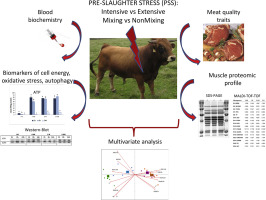当前位置:
X-MOL 学术
›
J. Proteomics
›
论文详情
Our official English website, www.x-mol.net, welcomes your
feedback! (Note: you will need to create a separate account there.)
What functional proteomic and biochemical analysis tell us about animal stress in beef?
Journal of Proteomics ( IF 2.8 ) Pub Date : 2020-02-25 , DOI: 10.1016/j.jprot.2020.103722 F Díaz 1 , A Díaz-Luis 2 , V Sierra 3 , Y Diñeiro 3 , P González 4 , S García-Torres 5 , D Tejerina 5 , M P Romero-Fernández 5 , M Cabeza de Vaca 5 , A Coto-Montes 6 , M Oliván 3
Journal of Proteomics ( IF 2.8 ) Pub Date : 2020-02-25 , DOI: 10.1016/j.jprot.2020.103722 F Díaz 1 , A Díaz-Luis 2 , V Sierra 3 , Y Diñeiro 3 , P González 4 , S García-Torres 5 , D Tejerina 5 , M P Romero-Fernández 5 , M Cabeza de Vaca 5 , A Coto-Montes 6 , M Oliván 3
Affiliation

|
Animal management practices may influence the animal's susceptibility to stress, with detrimental effects on the ultimate meat quality. In this field, proteomics is a promising tool that reveals the biological pathways underpinning the effect of animal's pre-slaughter stress (PSS) on the ultimate meat quality. The objective of this work was to study the effect of a pre-slaughter procedure that may promote stress, such as mixing unfamiliar animals during the transport and lairage period, on the post-mortem muscle proteome of young bulls reared under two different farm management systems (Intensive or Extensive). Comparative proteomics and biochemical analysis reveal the effect of PSS on biochemical pathways involved in the meat colour development, muscle redox status, energy metabolism and autophagy. This work highlights the potential of some muscle proteins such as Beclin-1 (autophagy marker), CKM (biomarker of energy transduction) and proteins of the energy metabolism (ALDOA, PYGM, PGM1, PKM, GPI) as potential biomarkers to discriminate beef samples according to the incidence of PSS. SIGNIFICANCE: Meat scientists are interested in the study of individual animal-based measurements that allow the detection of stress situations which could have negative effects on meat quality. In this context, the mechanisms underlying the adverse effects of pre-slaughter stress on the post-mortem muscle metabolism need to be elucidated in order to understand how animal stress may influence the conversion of muscle into meat. In this work, the study of proteome changes in the post-mortem muscle has allowed the identification of significant biomarkers of these processes that could be used as tools for detecting inappropriate strategies that may induce increased animal stress and, in consequence, may compromise the ultimate beef quality.
中文翻译:

哪些功能蛋白质组学和生化分析告诉我们有关牛肉中动物的压力?
动物管理实践可能会影响动物承受压力的敏感性,从而对最终肉质产生不利影响。在这一领域,蛋白质组学是一种很有前途的工具,它揭示了动物预屠宰应激(PSS)对最终肉质影响的生物学途径。这项工作的目的是研究在两种不同的农场管理制度下饲养的,可能加剧压力的屠宰前程序对运输过程中的压力,例如在运输和驯养期间混合不熟悉的动物,对公牛的死后肌肉蛋白质组的影响。 (强化或强化)。比较蛋白质组学和生化分析揭示了PSS对涉及肉色发展,肌肉氧化还原状态,能量代谢和自噬的生化途径的影响。这项工作强调了某些肌肉蛋白质(例如Beclin-1(自噬标记物),CKM(能量转导的生物标记物)和能量代谢的蛋白质(ALDOA,PYGM,PGM1,PKM,GPI)的潜力,作为区分牛肉样品的潜在生物标记物)的潜力。根据PSS的发生率。意义:肉类科学家对基于动物的个体测量方法的研究感兴趣,这些方法可以检测可能对肉质造成负面影响的压力状况。在这种情况下,需要阐明屠宰前应激对验尸后肌肉代谢的不利影响的潜在机制,以便了解动物应激如何影响肌肉向肉的转化。在这项工作中
更新日期:2020-02-26
中文翻译:

哪些功能蛋白质组学和生化分析告诉我们有关牛肉中动物的压力?
动物管理实践可能会影响动物承受压力的敏感性,从而对最终肉质产生不利影响。在这一领域,蛋白质组学是一种很有前途的工具,它揭示了动物预屠宰应激(PSS)对最终肉质影响的生物学途径。这项工作的目的是研究在两种不同的农场管理制度下饲养的,可能加剧压力的屠宰前程序对运输过程中的压力,例如在运输和驯养期间混合不熟悉的动物,对公牛的死后肌肉蛋白质组的影响。 (强化或强化)。比较蛋白质组学和生化分析揭示了PSS对涉及肉色发展,肌肉氧化还原状态,能量代谢和自噬的生化途径的影响。这项工作强调了某些肌肉蛋白质(例如Beclin-1(自噬标记物),CKM(能量转导的生物标记物)和能量代谢的蛋白质(ALDOA,PYGM,PGM1,PKM,GPI)的潜力,作为区分牛肉样品的潜在生物标记物)的潜力。根据PSS的发生率。意义:肉类科学家对基于动物的个体测量方法的研究感兴趣,这些方法可以检测可能对肉质造成负面影响的压力状况。在这种情况下,需要阐明屠宰前应激对验尸后肌肉代谢的不利影响的潜在机制,以便了解动物应激如何影响肌肉向肉的转化。在这项工作中











































 京公网安备 11010802027423号
京公网安备 11010802027423号